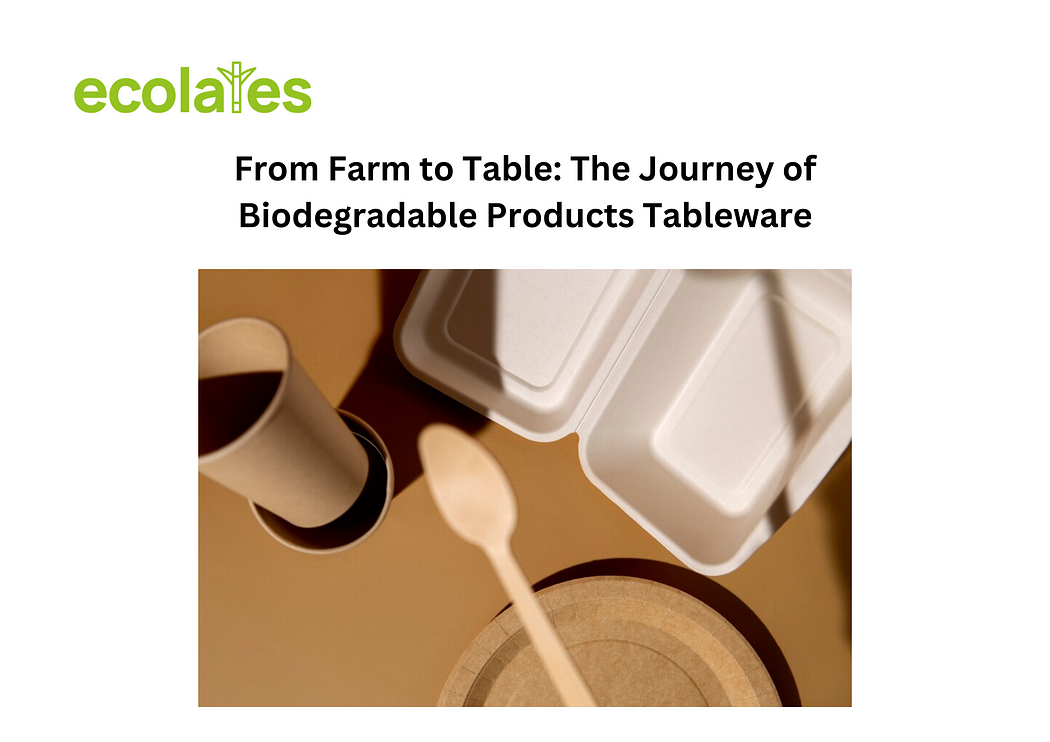From Farm to Table: The Journey of Biodegradable Products Tableware
 Introduction:
In today’s environmentally conscious world, the journey of our everyday
products has become a topic of growing interest. From the farm where
raw materials are sourced to the table where products are used,
understanding the lifecycle of biodegradable products tableware sheds
light on their sustainability and impact. In this blog, we embark on a
journey from farm to table, exploring the intricate process behind
biodegradable tableware and its significance in our quest for
eco-friendly alternatives.
Introduction:
In today’s environmentally conscious world, the journey of our everyday
products has become a topic of growing interest. From the farm where
raw materials are sourced to the table where products are used,
understanding the lifecycle of biodegradable products tableware sheds
light on their sustainability and impact. In this blog, we embark on a
journey from farm to table, exploring the intricate process behind
biodegradable tableware and its significance in our quest for
eco-friendly alternatives.
1. Sourcing Sustainable Materials: The journey of biodegradable products tableware begins at the source — farms cultivating renewable materials such as sugarcane fiber, bamboo, or plant-based plastics. These materials are carefully selected for their sustainability and ability to biodegrade, ensuring minimal environmental impact from the outset.
2. Harvesting and Processing: Once harvested, the raw materials undergo a series of processing steps to transform them into usable forms for manufacturing. Sugarcane fiber, for example, is extracted from sugarcane stalks and refined into pulp, while bamboo is cut and processed into fibers. This stage requires efficient and eco-friendly practices to minimize waste and energy consumption.
3. Manufacturing and Production: With processed materials in hand, manufacturers employ innovative techniques to craft biodegradable tableware products. Molded into various shapes and sizes, these products undergo rigorous quality control measures to ensure durability, functionality, and adherence to sustainability standards. The manufacturing process integrates renewable energy sources and eco-friendly practices to further reduce environmental impact.
4. Distribution and Packaging: Once manufactured, biodegradable products tableware embarks on the next leg of its journey — distribution to retailers and consumers. Sustainable packaging options, such as compostable bags or recycled cardboard, are utilized to minimize waste and promote eco-conscious practices throughout the supply chain.
5. Utilization and Consumption: At the heart of the journey lies the utilization of biodegradable tableware products by consumers. From picnics in the park to family gatherings at home, these eco-friendly alternatives offer a guilt-free dining experience without compromising on quality or convenience. The widespread adoption of biodegradable tableware reflects a growing consumer demand for sustainable options in everyday life.
6. End-of-Life: Unlike traditional plastic tableware, the journey of biodegradable products tableware does not end in landfills or oceans. Instead, these products biodegrade naturally over time, returning to the earth without leaving behind harmful pollutants or microplastics. Proper disposal methods, such as composting or recycling, ensure that biodegradable tableware completes its lifecycle in a sustainable manner.
7. Environmental Impact and Benefits: Throughout its journey, biodegradable products tableware offers numerous environmental benefits compared to conventional plastic alternatives. From reducing greenhouse gas emissions and conserving natural resources to minimizing waste and pollution, the adoption of biodegradable tableware contributes to a cleaner, greener planet for future generations.
Conclusion: In conclusion, the journey of biodegradable products tableware exemplifies the principles of sustainability and responsible consumption. From farm to table, each step in the lifecycle of these eco-friendly alternatives underscores their positive impact on the environment and society. By choosing biodegradable tableware, consumers can play a vital role in promoting sustainability and fostering a more harmonious relationship with nature.
#ecolates #ecolatespvtltd #bioderadableproducts #biodegradabletableware #ecofriendlyproducts #sustainableproducts

Comments
Post a Comment